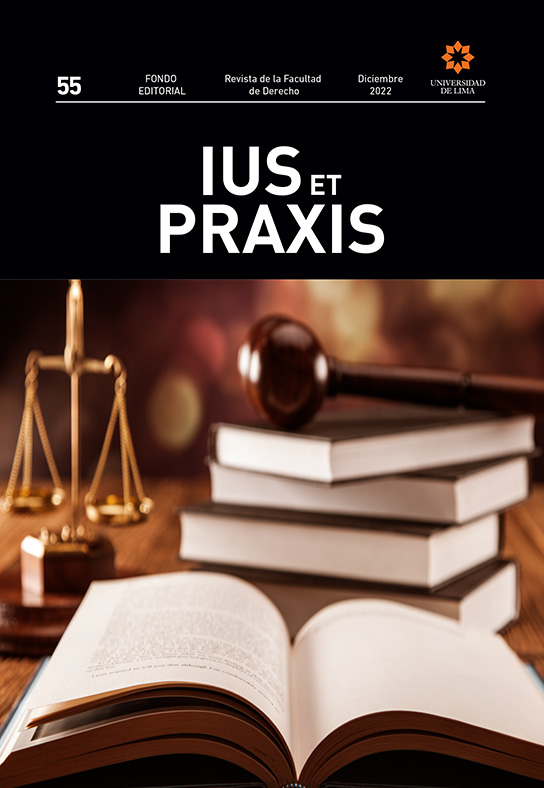The constitutional path: the legal bases of a new regime for de facto union heritage
DOI:
https://doi.org/10.26439/iusetpraxis2022.n055.6099Keywords:
constitutionalization, family, marriage, de facto union, patrimonial regimeAbstract
The constitutionalization of civil law has led to a rethinking of its institutions, including those related to family law. The de facto union, thanks to the family model of the 1993 Constitution, is recognized as a source that generates it. Despite the fact that important regulatory changes have been made —especially in their personal effects—, the patrimonial regime of the de facto union has been an aspect little attended to by the legislator. Thanks to the vagueness of article 326 of the Civil Code, the cohabitants have been prevented from opting for the regime of separation of assets, since it is considered that the community property is the only economic regime accessible to them. This unjustified imposition is contrary to the family protection mandate and the demands of a constitutional State. The present investigation aims to demonstrate that, with the current regulations (both civil and constitutional), there is sufficient legal basis to reverse said situation.
Downloads
References
Aguilar Llanos, B. (2006). Régimen patrimonial del matrimonio. Derecho PUCP, (59), 313-355.
Alexy, R. (2008). Teoría de los derechos fundamentales (2.a ed.) Centro de Estudios Políticos y Constitucionales.
García Toma, V. (2010). Teoría del Estado y derecho constitucional. Adrus.
Fernández Sessarego, C. (2000). Repensando el Código Civil peruano de 1984 en el umbral del nuevo milenio. Derecho PUCP, (53), 373-422.
Mantilla Espinosa, F. (2007). La “constitucionalización” del derecho privado. Revista Oficial del Poder Judicial, 1(2), 245-267.
Pérez Comenale, A. (2011). La administración de la sociedad de bienes en la unión concubinaria. Revista de Derecho, 10(20), 229-239.
Plácido Vilcachagua, A. (2013). El modelo de familia garantizado en la Constitución de 1993. Derecho PUCP, (71), 77-108.
Resolución 993-2019-SUNARP-TR-T (Trujillo). (2019, 19 de diciembre). Superintendencia Nacional de Registros Públicos: Pleno del Tribunal Registral. https://img.lpderecho.pe/wp-content/uploads/2020/09/Resolucion-993-2019-SUNARPTR-T-LP.pdf
Sánchez Martínez, O. (2000). Constitución y parejas de hecho: el matrimonio y la pluralidad de estructuras familiares. Revista Española de Derecho Constitucional, 20(58), 45-69.
Sentencia 0048-2004-PI/TC (Lima). (2005, 1 de abril). Tribunal Constitucional: Pleno jurisdiccional. https://tc.gob.pe/jurisprudencia/2005/00048-2004-AI.pdf
Sentencia 01817-2009-PHC/TC (Lima). (2009, 7 de octubre). Tribunal Constitucional: Sala Segunda. https://tc.gob.pe/jurisprudencia/2009/01817-2009-HC.pdf
Sentencia 03347-2009-PHC/TC (Lima). (2010, 17 de marzo). Tribunal Constitucional: Pleno Jurisdiccional. https://www.tc.gob.pe/jurisprudencia/2010/03347-2009-AA.html
Sentencia 04972-2006-PA/TC (La Libertad). (2007, 18 de diciembre). Tribunal Constitucional: Sala Primera. https://tc.gob.pe/jurisprudencia/2007/04972-2006-AA.pdf
Sentencia 09332-2006-PA/TC (Lima). (2007, 30 de noviembre). Tribunal Constitucional: Sala Primera. https://www.tc.gob.pe/jurisprudencia/2008/09332-2006-AA.pdf
Vega Mere, Y. (2003). Uniones de hecho. En W. Gutiérrez (Ed.), Código Civil comentado por los 100 mejores especialistas (t. II). Gaceta Jurídica.
Vega Mere, Y. (2010). Amor, familia, unión de hecho y relaciones patrimoniales. Foro Jurídico, (10), 41-59.
Zagrebelsky, G. (2016). El derecho dúctil. Editorial Trotta.


